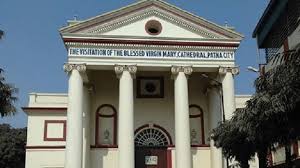 |
| Catholic church Padri_Ki_Haveli thesouthindianpost.com |
 |
| atholic church Padri_Ki_Haveli travelshoebum.com |
 |
| Patna city indmaps.com |
Joseph Rovato with ample support from the followers of Roman Catholics Cathedral of the Blessed Virgin Mary. It was during 1772-1779 major renovation work was undertaken under the guidance of Tirreto, a Venetian architect, who came from Calcutta for this purpose. Architecturally well designed, the church's structure is an impressive one with minute details and artistic work. The earlier building was a small one to accommodate more members for services. This church with a big dome and a fine pedimented iconic portico has an impressive bell donated in 1782 by Bahadur Shah, son of Prithvi Narayan , the Maharajah of Nepal. Measuring L70ft X W 40 ft X Ht, 50 ft., the church was subject to many raids and in the wake of skirmishes between English traders and the army of of Nawab Mir Kasim, the puppet Nawab of Bengal installed by the English company. Padri Ki Haveli was looted by the marauding army and in the mayhem that followed the ancient records kept inside the church were destroyed and burnt.
In 1857 there was a widespread uprising by the Indian soldiers against the unjust and oppressive English Company's rule across north India, The great rebellion was a period of hell-bent rioting, looting and killing and during this period, the church had to bear the attack by the rampaging soldiers and people.
Mother Teresa of Calcutta could not form a congregation in her early stage of social service because of lack of medical training to serve the sick. Hence, she came to the Holy Family Hospital in Patna to get training in first aid. During that period she had stayed here at the church- Padri-Ki-Haveli, for three month in 1948. Thus this place of worship is sanctified by a divine soul who till her demise cared for the poor and downtrodden of Calcutta city. The small room where she stayed is still well preserved and is part of the Missionaries of Charity house. The room has many things,
like cot, table etc., used by Mother Teresa during her stay. A message on the board in front of the room mentions: “Mother Teresa, who started her mission of love after undertaking training at Padri Ki Haveli, stayed in this room, 1948.” Mother Teresa, who was beatified by Pope John Paul II on October 19, 2003. After joining the Loreto Sisters of Dublin, she came to India in 1929 and changed her name to Sister Teresa. Before becoming a social worker to care for the 'poorest of the poor, Mother Teresa had spent 17 years teaching and as the principal of St Mary's High School in Kolkata.
Today, this church is a popular place of worship in Patna and is being visited by lots of people of different faiths.
https://www.rediff.com/news/2003/oct/20teresa.html



.jfif)
.jfif)




.jpg)